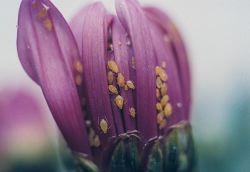Cornell's updated greenhouse guide shows how to do your plants a fava
By Blaine Friedlander
Have you ever wondered how to use yellow sticky cards to count whiteflies in a geranium greenhouse? Or, the best way to use fava bean plants to spot the presence of virus-carrying thrips? Do you know how to use duct tape to help your plants?
Those questions and many others are answered in the new edition of "Integrated Pest Management for Bedding Plants: A Scouting and Pest Management Guide" from Cornell University's New York State Integrated Pest Management Program (IPM).
This popular pocket guide covers managing greenhouse pests on annuals, perennials, herbs, vegetable transplants, foliage plants and flowering potted plants that are commonly produced in the greenhouse between January and July. Intended as a training guide for pest scouts, it's useful for private consultants, growers, greenhouse managers, pesticide applicators and students.
Edited by Christine Casey, a former Cornell IPM extension educator, the 117-page spiral-bound paperback now contains 41 color photographs, illustrations, expanded grower case studies, easy-to-use indexes, information from experts, scouting forms and an updated bibliography. In fact, the book is sturdy enough to endure greenhouse conditions.
It's a concise how-to guide for starting and operating a successful IPM program in greenhouses while maintaining profitable crop production. Readers will learn to identify and monitor common insect pests, diseases and nutrient deficiencies.
The guide also aids in developing an integrated pest-management plan; scouting techniques for insect pests and diseases; coping with noncontagious disorders such as nutrient deficiencies or spray injuries; weed management; and the successful use of biological control agents.
The book provides many answers to common plant problems:
- Yellow sticky cards attract such troublesome insect pests as thrips. Once stuck to the card's adhesive, these small insects easily can be counted. Save time by counting only those insects found in a one-inch vertical strip in the center of the card.
- Petunias and fava beans are good protectors of valuable plants such as poinsettias because both quickly indicate the presence of virus-carrying thrips. If planted at the same time as the poinsettias, these indicator plants will develop viral symptoms within a week if fed on by infected thrips.
- Duct tape wrapped on greenhouse workbench legs, with the adhesive side out, will reveal if slugs are moving from the greenhouse floor to your benches. Their slime trails will be visible on the tape.
- Insects dictate greenhouse fashion and are attracted by yellow, blue and other light-colored fabrics. Greenhouse workers should avoid wearing these colors to minimize the possibility of carrying insects from one area to another on their clothing.
- Tomato plants provide an early warning system, as they react quickly to the presence of ethylene, released when a gas heater burns inefficiently. The gas causes various plant problems including growth abnormalities, flower drop and leaf discoloration.
"Integrated Pest Management for Bedding Plants: A Scouting and Pest Management Guide" (Book #102IPM407), costs $14.50, which includes shipping. Order from the Cornell Resource Center, Cornell University, 7 Business and Technology Park, Ithaca NY, 14850. The Cornell Resource Center accepts payment by check, money order, VISA or MasterCard. Checks must be payable to Cornell University. If using a credit card, include expiration date. New York residents and businesses must add 8 percent sales tax. Or order by phone, (607) 255-2080, or send e-mail to: resctr@cornell.edu.
Media Contact
Get Cornell news delivered right to your inbox.
Subscribe